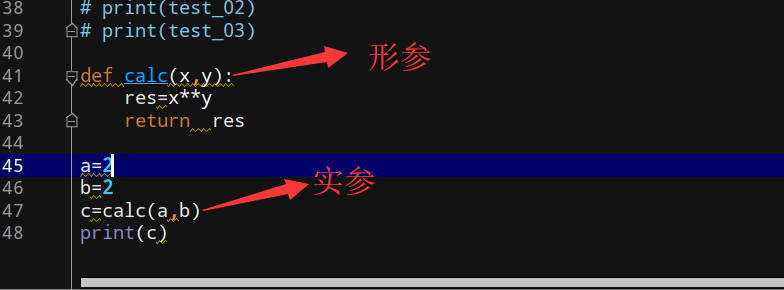Python3基础-函数
一、函数是分类
1、内置函数 Python解释器已经定义好了的函数即为内置函数;如len(),sum(),max()
2、自定义函数 根据自己的需求,制定好函数来实现某种功能
======================================================
使用函数的好处
1、代码重用
2、保持一致性,易维护
3、可扩展性
二、定义函数
1、如何自定义函数
1 #python中函数定义方法 2 def 函数名(参数1,参数2,参数3,...): 3 '''注释''' 4 函数体 5 return 返回的值 6 7 #函数名要能反映其意义 8 9 def:定义函数的关键字 10 test:函数名 11 ():内可定义的形参 12 函数体:泛指代码块或者程序处理的逻辑 13 returun:定义返回值 14 15 调用运行:可以带参数也可以不带 16 函数名()

#登录密码错误,有2次重新登录机会 带参数 def auth(username,passwd,count,sum_c): while sum_c > 1: if username == 'susu' and passwd == '123456': return 1 break sum_c = sum_c - count print("账号密码错误,还有%s机会"%(sum_c )) username = input("请输入账号:") passwd = input("请输入密码:") username = input("请输入账号:") passwd = input("请输入密码:") count=1 sum_c=3 login_success=auth(username,passwd,count,sum_c) if login_success == 1: print("登录成功") else: print("登录失败") print(auth) #函数 不带参数 def foo(): print("我就是随便发发文字而已") foo()
#空函数
def foo(): pass
2、函数:存在相同的函数名称出现的问题
#测试1-存在相同的函数名称 def foo(): print("我就是随便发发文字而已") def foo(): print("吖啊啊,我是另外一个相同的函数名称") foo() #执行结果 吖啊啊,我是另外一个相同的函数名称 #测试2-相同的函数名称,一个带参,一个不带参数 def foo(x): x += 1 print("我就是随便发发文字而已") def foo(): print("吖啊啊,我是另外一个相同的函数名称") x=1 foo(x) # 报错,因为第二个函数并没有带参数 TypeError: foo() takes 0 positional arguments but 1 was given
3、函数使用原则:先定义,后调用
#测试1 先调用函数 后定义 foo() #则会报错,NameError: name 'foo' is not defined def foo(): print("吖啊啊,我是另外一个相同的函数名称") #测试2 调用函数 没有定义函数 def foo(): print("吖啊啊,我是另外一个相同的函数名称") foo() foo1() #因为没有定义foo1()函数,则报错NameError: name 'foo1' is not defined #测试3 多个函数调用 def foo(): print("我是老大") foo1() def foo1(): print("我是老二") foo() #先定义函数 后调用 #测试4 # def foo(): # print("我是老大") # foo1() # foo() #因为定义foo1() 是在调用foo()函数后面 # def foo1(): # print("我是老二") #则会报错 NameError: name 'foo1' is not defined
4、函数返回值
1、过程:就是没有返回值的函数 无return ->None 2、return 1个值-》返回一个值 3、return 逗号分割多个值-》元祖
#无return
def test01(): print("吖啊啊,我是另外一个相同的函数名称")
#return 1个值 def test02(): x=1 return x
#return 多个值 def test03(): x=1 return x,1,2,3,(1,2),[1,2,'a'] test_01=test01() test_02=test02() test_03=test03() print(test_01) print(test_02) print(test_03) """ 执行结果 None 1 (1, 1, 2, 3, (1, 2), [1, 2, 'a']) """
5、函数的参数
形参即变量名,实参即变量值,函数调用时,将值传到变量名上,函数调用结束,

测试1-位置参数,必须从左到右顺序一一对应
#实参与形参一一对应 def calc(x,y): res=x**y return res
c=calc(2,3) print(c) #实参缺失 c=calc(2) #实参缺失一个 报错TypeError: calc() missing 1 required positional argument: 'y' #实参多个 c=calc(2,2,3)#实参比形参多,报错TypeError: calc() takes 2 positional arguments but 3 were given
测试2-关键字参数,根据key=value的形式定义实参;无需一一对应,缺一不可;对同一个形参不能重复传值 #实参与形参无一一对应 def calc(x,y): res=x**y return res c=calc(y=2,x=1) print(c) #可以正常输出 c=calc(y=2) #报错 TypeError: calc() missing 1 required positional argument: 'x' c=calc(y=2,x=1,z=0) #报错TypeError: calc() got an unexpected keyword argument 'z'
测试3-位置参数和关键字参数一起混合使用,位置参数必须在关键字左边 def test(x,y,z): print(x,y,z) #test(1,2,x=4) #TypeError: test() got multiple values for argument 'x' 因为位置参数1 已经传参给x 了;所以再重新赋值就会报错 #test(1,y=2,3) #报错 SyntaxError: positional argument follows keyword argument test(1,2,z=3) #正常输出 1 2 3 test(1,y=2,z=3) #正常输出 1 2 3
#test(1,2,z=3,y=1) #TypeError: test() got multiple values for argument 'y' 因为位置参数2 已经传参给y 了;所以再重新赋值就会报错
测试4-默认参数 形参在定义时就已经为其赋值
def test(x,y=2,z=3): print(x,y,z) test(1) #可正常输出1,2,3 ; 1传参给x ,y、z有默认值 test(1,4) #根据位置参数一一对应关系,则输出的是1,4,3 test(y='a',z='b',x='c') #则输出 c a b
测试5-可变长参数 1、**字典 2、*列表
-----------------*列表----------------------------------- #实参 2,'a','b',{"a":1},True def test(x,*args): print(x,args) #输出1 (2,'a', 'b', {'a': 1}, True) print(args[0]) #输出 2 test(1,2,'a','b',{"a":1},True) #实参 ['c','a','b',{"a":1},True] def test(x,*args): print(x,args) #输出1 (['c', 'a', 'b', {'a': 1}, True],) 列表中就一个元素 print(args[0]) #输出 ['c', 'a', 'b', {'a': 1}, True] print(args[0][0]) #输出c test(1,['c','a','b',{"a":1},True]) #实参 *['c','a','b',{"a":1},True] def test(x,*args): print(x,args) #输出 1 ('c', 'a', 'b', {'a': 1}, True) print(args[0]) #输出 c test(1,*['c','a','b',{"a":1},True]) #参数不传给*args def test(x,*args): print(x,args) #输出 1 () test(1)
#-----------------**字典----------------------------------- #实参 x=1,y=2,z=3,d='aa' def test(x,**args): print(x,args) #1 {'y': 2, 'z': 3, 'd': 'aa'} test(x=1,y=2,z=3,d='aa') #实参**{'b=2':2} test(1,**{'b=2':2}) #1 {'b=2': 2} #实参*{'b=2':2} #test(1,*{'b=2':2})#报错 TypeError: test() takes 1 positional argument but 2 were given #实参{'b=2':2} #test(1,{'b=2':2})#报错 TypeError: test() takes 1 positional argument but 2 were given #test(x=1,**{'x':1,'aa':2}) #报错 TypeError: test() got multiple values for keyword argument 'x' #实参 **{'z':1,'y':2,'x':3} 形参 x,y,z def test(x,y,z): print(x,y,z) test(**{'z':1,'y':2,'x':3}) #输出的是3 2 1 def test(x,*args,**args1): print(x,args,args1) test(1,2,3,4,5,6,7,8,1,name='d',d='aa')#1 (2, 3, 4, 5, 6, 7, 8, 1) {'name': 'd', 'd': 'aa'} #test(1,*['a','b','c'],**{'yuyu':1,3:'x'})#报错TypeError: test() keywords must be strings test(1,*['a','b','c'],**{'yuyu':1,'xxx':'x'}) #1 ('a', 'b', 'c') {'yuyu': 1, 'xxx': 'x'} -----------无参数------------ def test(*args,**args1): print(args,args1) test() #输出结果() {} test(2) #输出结果 (2,) {} test('alex',18,'malx','x',yy=34) #输出结果('alex', 18, 'malx', 'x') {'yy': 34}




 浙公网安备 33010602011771号
浙公网安备 33010602011771号